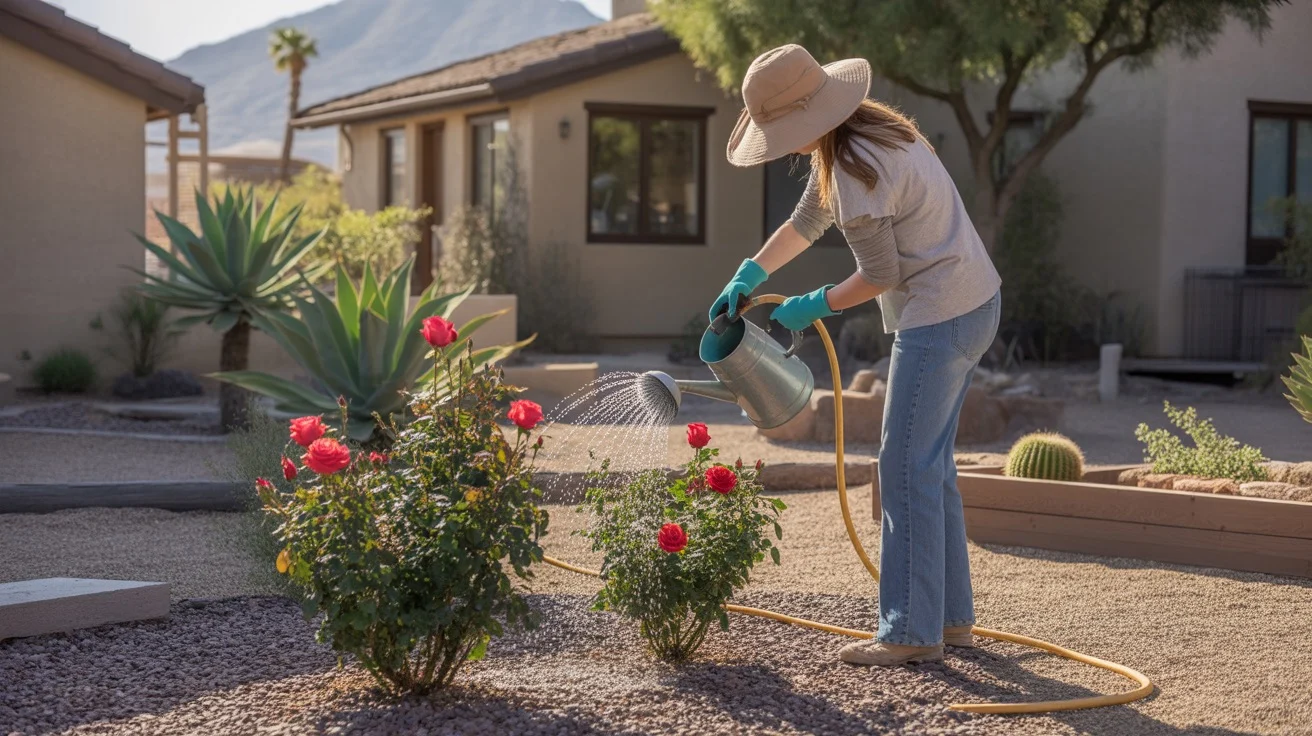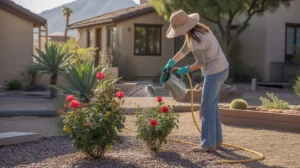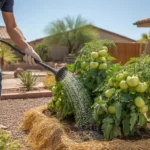Growing gorgeous roses in Mesa’s intense desert climate takes some know-how, especially when it comes to watering. The key is to work with the natural rhythms of morning dew and cooler evening temperatures to keep your roses hydrated and happy, even on the hottest summer days. With a few simple adjustments to your watering routine, you can enjoy a vibrant rose garden that thrives in the Mesa heat.

The Importance of Morning Watering for Roses
One of the most important things to understand about watering roses in Mesa is the power of morning moisture. Roses love a good drink in the early hours, when the air is cool and the sun is just starting to peek over the horizon. This mimics the natural process of morning dew, which helps to refresh and hydrate plants after a long night.
Watering your roses in the morning has several key benefits. First, it allows the water to soak deep into the soil before the heat of the day evaporates it away. This encourages strong, deep root growth that helps roses withstand the intense afternoon sun. Morning watering also gives the leaves and stems time to dry off before nightfall, which reduces the risk of fungal diseases that thrive in cool, damp conditions.
To make the most of morning watering, aim to give your roses a deep drink at least once or twice a week, depending on the temperature and your soil type. Use a soaker hose or drip irrigation system to deliver water slowly and directly to the roots, avoiding the leaves. Water for long enough to moisten the soil to a depth of at least 6 inches, which encourages roses to develop extensive root systems.
The Benefits of Evening Showers for Roses
While morning watering should be the foundation of your rose care routine, adding in an occasional evening shower can work wonders in Mesa’s hot, dry climate. After a long day of intense sun and heat, roses appreciate a gentle, refreshing sprinkle to cool off and rehydrate.
The key to successful evening watering is timing and technique. Wait until the sun has dipped below the horizon and the air has started to cool, usually after 6pm in the summer months. Use a fine spray nozzle or mister to gently wet the leaves and stems, being careful not to soak the soil. The goal is to mimic a light, cooling rain shower, not a deep watering.
Evening showers offer several benefits for Mesa roses. They help to wash away dust and debris that can clog pores and interfere with photosynthesis. The cool moisture also helps roses recover from heat stress and improves their overall vigor and disease resistance. Just be sure to keep the spray light and brief, and allow plenty of time for the leaves to dry before the cool night air settles in.
Adjusting Your Watering Schedule for the Season
As the seasons change in Mesa, so should your rose watering schedule. In the cooler months of spring and fall, your roses will need less frequent watering than in the peak of summer. A good rule of thumb is to check the soil moisture with your finger before watering. If the top inch of soil feels dry, it’s time to give your roses a drink.
In the summer, when temperatures regularly soar above 100°F, your roses may need watering every 2-3 days to stay hydrated and healthy. Again, let the soil be your guide. If it feels dry and crumbly, or if you see signs of wilting or crispy leaf edges, increase your watering frequency.
It’s also important to adjust your watering volume and duration based on your soil type. Mesa’s sandy soils drain quickly and may need more frequent, shorter watering to keep roses hydrated. Clay soils, on the other hand, hold moisture longer and may only need deep watering once a week. Understanding your soil’s unique characteristics will help you fine-tune your watering routine for optimal rose health.
Mulching and Moisture Retention for Mesa Roses
One of the best ways to maximize the benefits of your morning and evening rose watering is to use mulch. A 2-3 inch layer of organic mulch, such as shredded bark or compost, helps to insulate the soil, retain moisture, and regulate temperature fluctuations.
Mulch works by creating a protective barrier over the soil surface that slows down evaporation and keeps the roots cool and moist. It also helps to suppress weeds that compete with your roses for water and nutrients. As the mulch breaks down over time, it adds organic matter to the soil, improving its structure and water-holding capacity.
When applying mulch around your roses, be sure to keep it a few inches away from the base of the stems to prevent rot and disease. Refresh the mulch layer as needed throughout the growing season, especially after heavy rains or watering that can wash it away.
Watering Newly Planted Roses in Mesa
If you’re adding new roses to your Mesa garden, they’ll need some extra TLC when it comes to watering. Newly planted roses have limited root systems that can’t yet reach deep into the soil for moisture, so they rely on you to provide consistent hydration.
For the first few weeks after planting, water your new roses deeply every 2-3 days, or whenever the top inch of soil feels dry. Use a gentle stream of water to avoid disturbing the delicate roots, and water slowly to allow the moisture to penetrate the root zone.
As your roses establish and put on new growth, you can gradually transition to the morning dew and evening shower routine outlined above. Keep a close eye on your new plants, and adjust your watering schedule as needed based on their size, growth rate, and overall health.
Signs of Overwatering or Underwatering Roses
Even with the best intentions, it’s possible to give your Mesa roses too much or too little water. Knowing the signs of overwatering and underwatering can help you catch problems early and adjust your routine accordingly.
Overwatered roses may show symptoms such as yellowing leaves, wilting or drooping stems, and stunted growth. The soil may feel soggy or have a sour smell, and you may see mushrooms or other fungi growing around the base of the plant. If you suspect overwatering, ease up on your watering frequency and make sure your roses have good drainage to prevent waterlogging.
Underwatered roses, on the other hand, may have crispy, brown leaf edges, wilting or curling leaves, and slow or stunted growth. The soil may feel dry and hard, and the stems may be brittle or woody. If you see these signs, increase your watering frequency and volume, and consider adding mulch to help retain moisture.
Watering Roses During Extreme Heat Waves
Even with a consistent morning dew and evening shower routine, Mesa’s intense summer heat waves can put extra stress on your roses. When temperatures climb above 110°F for several days in a row, your roses may need some extra hydration and TLC to stay healthy.
During extreme heat events, consider giving your roses a deep watering in the morning, followed by a light misting in the evening to help them cool off. You can also provide temporary shade by draping a light cloth or shade netting over your rose bushes during the hottest part of the day.
Be sure to keep an eye out for signs of heat stress, such as wilting, scorching, or leaf drop, and take action quickly to prevent long-term damage. With a little extra care and attention, your roses can weather even the most intense Mesa heat waves and come out blooming strong.
The Role of Soil Amendments in Rose Watering
In addition to mulch, soil amendments can play a key role in helping your Mesa roses make the most of your morning and evening watering routine. Adding organic matter, such as compost or well-rotted manure, to your soil can improve its structure, drainage, and water-holding capacity.
Soil amendments work by creating tiny pockets and channels in the soil that allow water and air to penetrate more easily. This helps to prevent compaction and waterlogging, while also encouraging deep root growth and healthy microbial activity.
When incorporating soil amendments into your rose beds, aim to mix in a 2-3 inch layer of organic matter every spring or fall. Use a garden fork or tiller to work the amendments into the top 6-8 inches of soil, being careful not to damage the rose roots. Over time, regular additions of organic matter will help to create a rich, loamy soil that supports healthy rose growth and efficient water use.
Watering Roses in Containers or Raised Beds
If you’re growing roses in containers or raised beds in Mesa, you may need to adjust your watering routine to account for the unique challenges of these growing environments. Containers and raised beds tend to dry out more quickly than in-ground beds, especially in the intense desert heat.
To keep your container or raised bed roses well-hydrated, aim to water them deeply and frequently, especially during the summer months. Use a moisture meter or your finger to check the soil moisture level daily, and water whenever the top inch of soil feels dry.
Consider using a self-watering container or drip irrigation system to provide consistent moisture to your roses without the hassle of daily hand-watering. These systems work by slowly releasing water into the soil over time, helping to maintain even moisture levels and prevent stress from drought or overwatering.
Conclusion
By working with the natural rhythms of morning dew and evening showers, you can keep your Mesa roses thriving through even the hottest desert summers. Remember to water deeply and consistently, adjust your schedule for the season and your soil type, and use mulch and soil amendments to maximize moisture retention and root health.
With a little extra care and attention, you can enjoy a stunning rose garden that blooms with vibrant color and fragrance all year round. So embrace the power of morning dew and evening showers, and watch your Mesa roses flourish in the desert heat.











